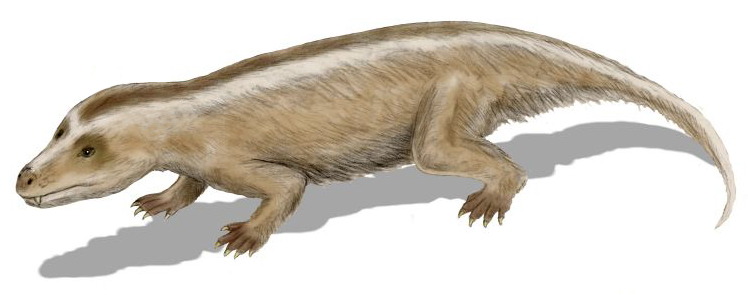[Recent Entries][Archive][Friends][User Info]
| Time | Text |
|---|---|
| 02:57 pm [Link] |
Tritylodon Trityldon (Greek for 3 cusped tooth) was a genus of tritylodont, one of the most advanced group of cynodont therapsids. They lived in the Early Jurassic and possibly Late Triassic periods along with dinosaurs. They also shared a lot of characteristics with mammals, and were once considered mammals because of overall skeleton construction. That was changed due to them retaining the vestigial reptilian jawbones and a different skull structure. Trityldons are now regarded as synapsids (often called "mammal-like reptiles"). If a living Tritylodon were to be seen today, it would look a lot like a large rodent. They were about 1 foot (0.3 m) long but there is no certainty about the exact weight. Also the way they ate was much like a rodent, doing a grinding motion with the bottom teeth sliding against the top teeth. The bottom teeth were much like a set of cusps and the top teeth were a set of matching grooves that matched perfectly allowing this motion. There were large incisors at the very front of their mouth separated by a gap from the rest of the teeth. Even with their mouth closed the incisors would still stick out slightly visible. The legs were directly beneath the body like mammals, unlike the earlier therapsids with sprawling limbs. These animals were burrowers; the structure of the shoulder and front limbs show this. Also the large front incisors worked very well with helping digging and getting buried plant parts. Tritylodons were strictly herbivores based on the way they ate and shape of teeth are proof. Any of the Tritylodonts including Tritylodon were warm-blooded or endothermic. Another interesting thing about them was that they were oviviparous. With partial reptile characteristics and mammal characteristics, the Tritylodon part of the Tritylodont family could be part of the link between reptiles and mammals. Some argue that Tritylodonts were too specialized, and were outcompeted by carnivorous archosaurs and other newly evolving early mammals, to become such a link. There is some possible evidence of a link to the group multituberculata. The features of the multituberculata group do match a lot of characteristics of the order Monotremata which includes the egg laying mammals: the duck-billed platypus and echidna. The Tritylodons' habitat was limited to the forests of south Africa, with other fossils found in the Mount Kirkpatrick Formation of Antarctica. When the species originated, about 200 million years ago, the African area was dryer and hotter. But for most of their existence the climate was tropical and wetter. The Tritylodon fossils in south Africa are found concentrated mainly in an area about 11,000 km² (4,250 mi²). They have been found in floodplain deposits of the Lower Jurassic Elliot Formation (upper Karoo Supergroup). In this area there have been so many findings it has been named the Tritylodon Acme Zone. The fossil findings have all been in the Orange Free State of South Africa. The genus Tritylodon of the Tritylodonts is restricted to the south African forms: Tritylodon longaevus and Tritylodon maximus. It is suggested that T. maximus is either a large T. longeavus or a closely related species. If it is a closely related species it could possiby be ecological succession since the larger T. maximus fossils have been dated in the Sinemurian–Pleisbachian mainly less than 190 million years ago and the T. longaevus in the Hettangian–Sinemurian mainly more than 190 million years ago. With the fossil findings of each species overlapping in Sinemurian stage, the fossils show two differences, T. maximus being larger and having nine upper postcanines (neither species had canine teeth) instead of the seven teeth like T. longeavus. All other structures of the two Tritylodon species were the same.
|
| Reply: | |




